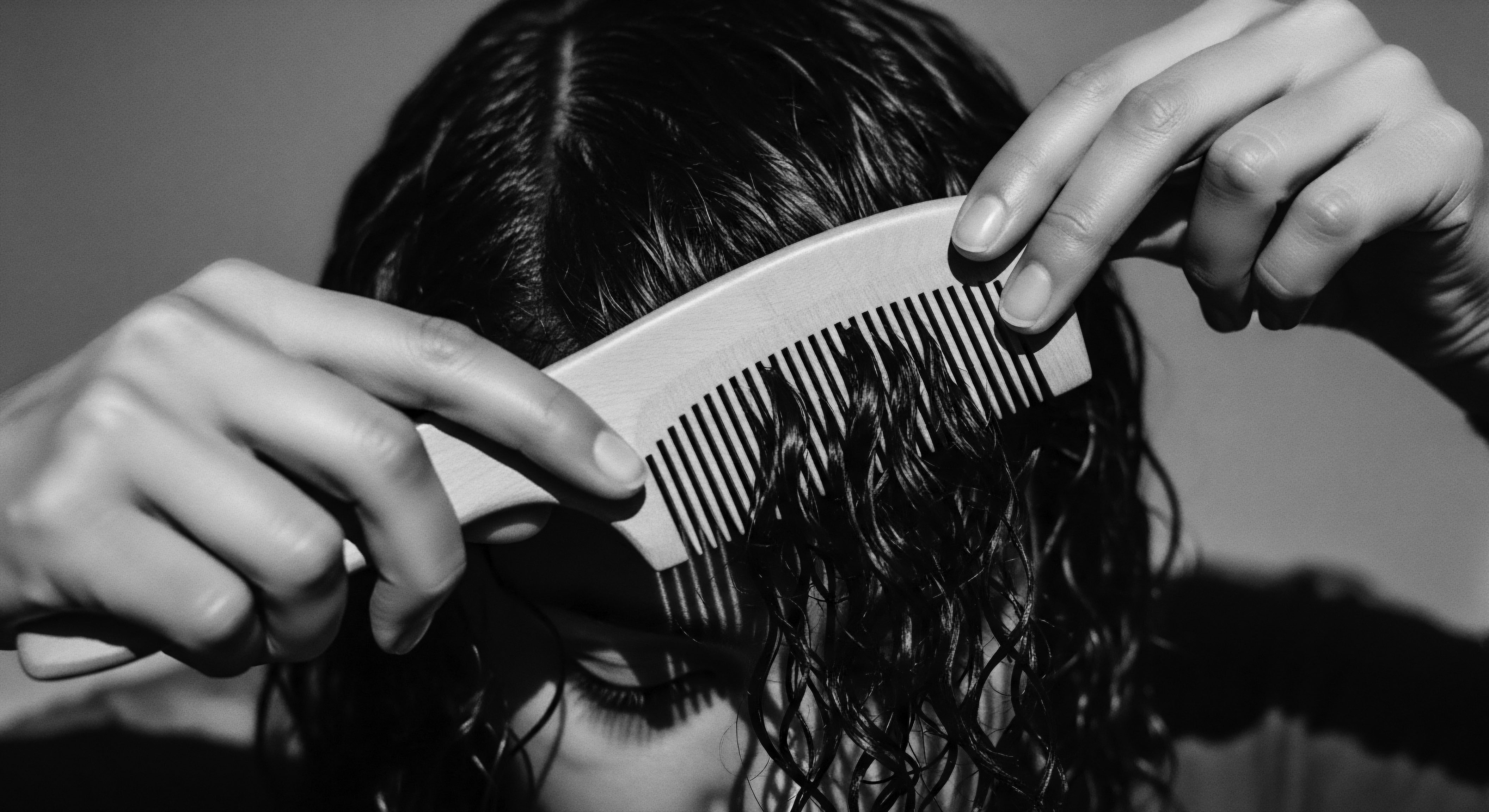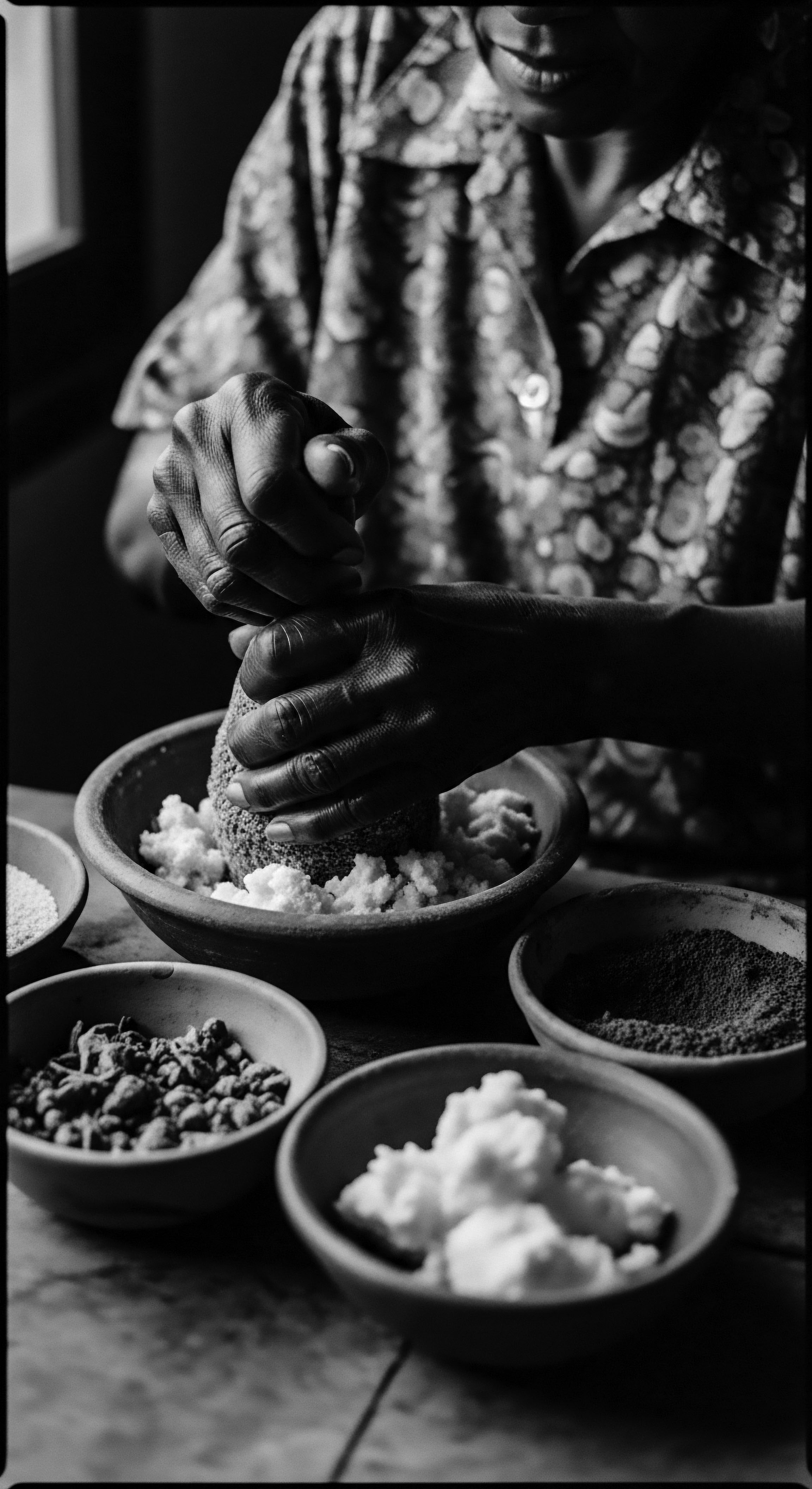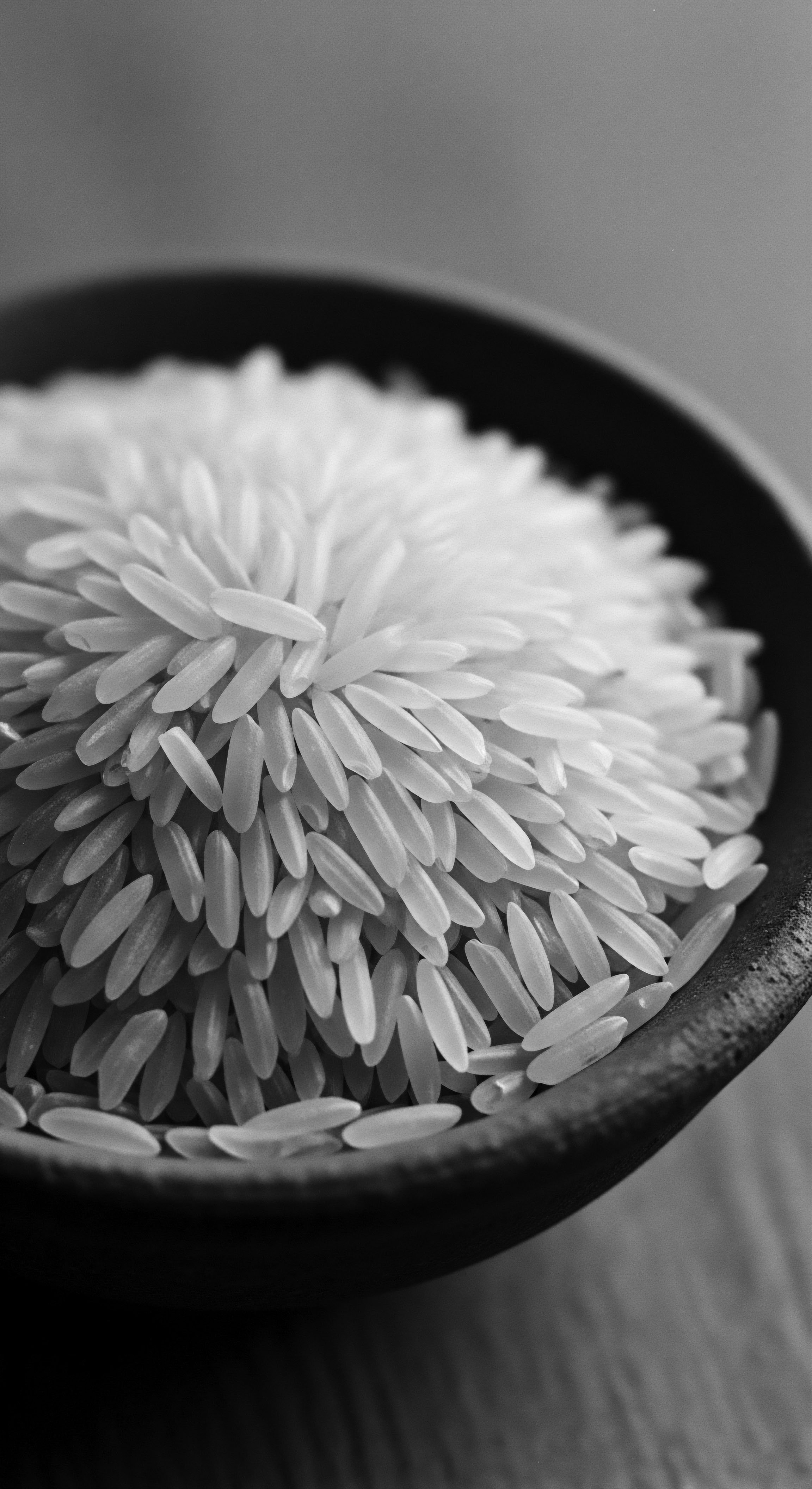
Fundamentals
The art of adornment, a practice woven into the very fabric of human existence, finds a profound expression in the realm of cosmetic chemistry. At its simplest interpretation, cosmetic chemistry represents the scientific pursuit dedicated to creating products that alter external appearance or natural scent. From ancient pictographs depicting Egyptians lining their eyes with darkening compounds to the intricate formulations of the modern era, the underlying purpose of enhancing one’s physical presentation remains constant.
This field applies rigorous scientific principles to formulate substances intended to cleanse, beautify, promote allure, or modify physical characteristics without altering the body’s fundamental structure or function. It is a discipline that bridges the divide between historical custom and contemporary innovation, revealing the enduring human desire to connect with beauty.
Consider the ancient wisdom embedded within seemingly simple preparations. Long before laboratories with precise instruments, our ancestors across the globe, particularly within African communities, engaged in sophisticated forms of cosmetic chemistry. They understood the properties of natural elements—the nourishing quality of plant oils, the protective shield offered by mineral clays, the cleansing power of certain ashes.
These early chemists, often women steeped in generational knowledge, meticulously gathered, processed, and combined ingredients from their immediate environments. This ancestral understanding laid the groundwork for what we now categorize under scientific principles, showcasing an innate grasp of material interactions and their effects on hair and skin.
Cosmetic chemistry, at its heart, is the study of how substances interact to enhance external appearance, a discipline that resonates deeply with ancestral practices of adornment.
The foundational elements of this science manifest in everyday products. Hair care items, skin preparations, ornamental applications, and fragrances all fall within its purview. Individuals who dedicate themselves to this field possess an extensive understanding of a wide array of raw materials permitted in cosmetic formulations.
This body of knowledge extends beyond mere ingredient lists; it encompasses the physical and chemical properties of each component, their stability, their compatibility with others, and their interactions with human physiology. The quest for healthy, vibrant hair has been a persistent thread throughout human history, leading to an intuitive form of cosmetic chemistry that predates formal scientific inquiry.
Understanding the basic mechanisms reveals how even the most rudimentary applications work. For instance, creating a smooth, spreadable balm requires substances that repel each other, such as oil and water, to be held in a stable mixture. This forms an Emulsion, a core concept in cosmetic formulation.
Similarly, the use of certain plant extracts to impart color or scent relies on their inherent chemical composition. This ancient ingenuity, passed down through oral traditions and communal rituals, was a practical application of chemical principles long before they were codified.

Intermediate
Moving beyond the foundational tenets, the intermediate understanding of cosmetic chemistry delves into the nuanced interplay of ingredients and their specific roles, particularly within the context of textured hair care. This scientific domain examines how various molecules interact to achieve desired effects, transitioning from general principles to specialized applications. When considering textured hair, the inherent structure of the hair shaft and its unique requirements necessitate a tailored approach to cosmetic formulation.
The coils and kinks of Afro-textured hair, for instance, are known for their propensity towards dryness due to the challenging journey of natural oils from the scalp along the length of the strand. This characteristic makes moisture retention a paramount concern, driving the selection and combination of specific ingredients.
The distinction between ancient remedies and contemporary products often lies in the precision of formulation rather than a complete departure from core chemical principles. For example, traditional hair greases and butters, often crafted from plant oils and waxes, functioned as occlusives, creating a barrier to seal in moisture. Modern cosmetic chemistry refines this concept, using emulsifiers to create lighter, more stable creams and lotions that still deliver profound hydration without necessarily occluding the hair shaft excessively. This evolution reflects a continuous quest for optimal performance while often drawing inspiration from time-honored practices.
The journey from simple ancestral balms to sophisticated modern formulations for textured hair illustrates a continuous evolution of cosmetic chemistry, always centered on moisture and protection.
A significant area of study involves the properties of various ingredient types:
- Emollients ❉ These ingredients soften and smooth the hair, often by filling in gaps in the cuticle, creating a more supple feel. Shea butter, a venerable ingredient in African hair care, exemplifies a natural emollient that has been used for centuries to protect and moisturize hair. Its complex lipid profile provides conditioning benefits.
- Humectants ❉ Substances like glycerin draw moisture from the air into the hair, aiding in hydration. Many ancestral practices involving plant gels or honey contained natural humectants that served a similar purpose.
- Proteins ❉ Hydrolyzed proteins can temporarily strengthen the hair shaft by binding to damaged areas, offering a protective layer. Though not explicitly identified as “proteins” by ancient practitioners, the use of ingredients like certain plant milks or fermented substances might have inadvertently provided amino acids beneficial for hair resilience.
- Surfactants ❉ These compounds, present in cleansers, create lather and lift away dirt and oils. Traditional African black soap, a celebrated cleanser, uses plantain skins, cocoa pods, and shea tree bark, which naturally contain saponins—compounds with surfactant properties.
The effectiveness of ancestral formulations, such as the use of Chebe Powder by the Basara Arab women of Chad, offers a compelling intermediate-level case study. This traditional remedy, composed of ingredients like Croton zambesicus, Mahllaba Soubiane, cloves, and resin, is not primarily for hair growth from the scalp but rather for retaining length by minimizing breakage and securing moisture within the hair strands. The practice involves coating damp, sectioned hair with a mixture of the powder and oils, then braiding it, allowing the natural components to fortify the hair shaft, reduce split ends, and improve elasticity over days. This long-standing method speaks to an intuitive understanding of protective styling and the chemical benefits of these plant-based ingredients for kinky and coily hair types.
The wisdom of these traditions, rooted in deep observation and generational experimentation, serves as a testament to humanity’s early grasp of material science. The chemical profiles of traditional ingredients, often complex and synergistic, provided benefits that modern analysis now seeks to replicate or enhance. The continued presence of ingredients like shea butter and plant oils in contemporary formulations for textured hair is a direct nod to this ancestral legacy, highlighting a practical convergence of ancient knowledge and contemporary scientific understanding.

Academic
The academic delineation of cosmetic chemistry transcends simple descriptions of product efficacy to explore the intricate molecular interactions and biological mechanisms underpinning cosmetic action. At this rigorous stratum, cosmetic chemistry is understood as a specialized sub-discipline of applied chemistry, integrating principles from organic chemistry, physical chemistry, analytical chemistry, and biochemistry to design, formulate, produce, and evaluate products intended for application to the external human body, including the hair, skin, nails, lips, and oral cavity. Its profound significance for textured hair lies in the meticulous investigation of hair fiber morphology, chemical composition, and biomechanical properties specific to diverse ancestral hair patterns, thereby enabling the development of targeted care solutions that honor and preserve hair health across racial and ethnic lines. The field is not merely about aesthetic enhancement; it involves a deep engagement with safety toxicology, regulatory science, and the ethical implications of product development, particularly when considering the historical context of beauty standards and their impact on communities of color.
The chemical composition of human hair, though largely consistent across ethnic groups in terms of its primary protein, Keratin, exhibits structural nuances that profoundly influence its response to chemical and physical treatments. Afro-textured hair, characterized by its elliptical cross-section, tighter curl patterns, and fewer cuticle layers at the curve points, is inherently more susceptible to mechanical damage and moisture loss compared to straight or wavy hair types. This specific architecture dictates that formulations must account for heightened needs for lubrication, conditioning, and protection against fracture.
For instance, the traditional African practice of using hair greases and butters, such as Shea Butter or those incorporating Chebe Powder, effectively provided a physical barrier to moisture evaporation and reduced friction between strands. Academically, this is explained by the occlusive properties of lipids and their ability to form a hydrophobic film, minimizing transepidermal water loss from the scalp and preventing desiccation of the hair shaft.
A striking illustration of ancestral cosmetic chemistry’s scientific depth appears in the traditional preparation of shea butter. The indigenous methods of extracting shea butter, primarily from the nuts of the shea tree (Vitellaria paradoxa), involve a series of sophisticated physiochemical transformations. These traditional processes typically include harvesting, crushing, roasting, grinding, kneading, and boiling. Roasting, a critical thermal pre-treatment, influences the chemical composition of the final butter.
Studies on traditional shea butter extraction reveal that the roasting process can affect the butter’s free fatty acid content and oxidative stability. For example, boiling shea kernels prior to extraction results in higher free fatty acid content and a greater fat yield compared to smoking the kernels. While boiling might lead to a softer texture and more intense smell, the overall quality parameters, including acid value, iodine value, and peroxide value, remain largely consistent regardless of traditional method, distinguishing them from modern chemical extractions that sometimes yield higher oil content but may compromise stability. This rigorous, multi-step process, perfected over generations, exemplifies an empirical understanding of chemical extraction and purification long before the advent of modern laboratories. The result is a butter rich in oleic acid (around 45%) and stearic acid (42–44%), essential fatty acids that comprise nearly 90% of its total fatty acid profile, providing its renowned moisturizing and protective capabilities.
The ancestral methods for preparing shea butter, involving careful thermal processing, showcase an intuitive understanding of lipid chemistry, affecting its fatty acid profile and stability.
The enduring connection between hair identity and chemical alteration, particularly within Black and mixed-race communities, provides a compelling academic lens through which to view cosmetic chemistry. Historically, the imposition of Eurocentric beauty standards led to widespread reliance on chemical relaxers to straighten naturally coily hair. Early relaxers often contained highly alkaline substances, such as sodium hydroxide (lye), with pH values exceeding 12. The chemical mechanism involves the irreversible breaking and rearrangement of disulfide bonds within the hair’s keratin structure.
This process, known as lanthionization, alters the hair’s morphology to a permanently straightened state. While effective in changing hair texture, these formulations could cause severe scalp burns and significant hair breakage if not applied with extreme care, presenting substantial health implications.
The subsequent development of “no-lye” relaxers, utilizing guanidine hydroxide or calcium hydroxide, aimed to mitigate some of these harsh effects by offering a less irritating alternative, though still operating on similar principles of disulfide bond reduction and reformation. The academic study of these chemical treatments, from their destructive potential to their long-term effects on hair integrity and scalp health, underscores the crucial role of cosmetic chemistry in both fulfilling and challenging societal beauty norms. Research continues to explore the links between chemical hair products and potential health risks, particularly endocrine disruptors, a matter of significant concern for the Black women who have historically been the primary consumers of these products.
The natural hair movement, which gained significant momentum in the early 2000s, represents a profound cultural shift with direct implications for cosmetic chemistry. This movement, advocating for the acceptance and celebration of natural, un-straightened hair textures, has propelled demand for formulations that prioritize moisture, definition, and protective care. Cosmetic chemists now face the intricate task of developing products that work synergistically with the unique architecture of coiled and kinky hair. This involves:
- Optimized Surfactant Systems ❉ Formulating shampoos and co-washes that cleanse effectively without stripping the hair’s natural oils, often utilizing milder, sulfate-free surfactants.
- Advanced Conditioning Agents ❉ Designing deep conditioners and leave-ins that can penetrate the hair shaft, lubricate the cuticle, and provide long-lasting moisture retention, often incorporating high molecular weight polymers and rich butter/oil complexes.
- Styling Aids for Definition ❉ Crafting gels, creams, and mousses that enhance curl pattern, reduce frizz, and provide hold without causing stiffness or flaking, often relying on film-forming polymers and humectants.
An academically noteworthy development is the increasing scientific validation of traditional plant-based ingredients within modern cosmetic frameworks. For example, a survey of plants used for hair care by individuals with Afro-textured hair identified 12 plant species with beneficial properties, including Ricinus Communis (Castor oil), Cocos Nucifera (Coconut oil), and Vitellaria Paradoxa (Shea butter). These botanical extracts contain a complex array of phytochemicals—like antioxidants, fatty acids, and anti-inflammatory compounds—that can support hair health, scalp wellness, and even stimulate growth. The academic scrutiny of these traditional remedies, moving beyond anecdotal evidence to analyze their precise chemical constituents and mechanisms of action, represents a powerful convergence of ancestral knowledge and contemporary scientific rigor.
This inquiry validates the wisdom passed down through generations, showcasing how ancestral cosmetic chemistry, though unlabelled as such, was inherently scientific in its empirical observation and application of natural properties. The ongoing dialogue between these two worlds enriches our understanding of hair care and propels the evolution of formulations that truly serve the diverse needs of textured hair.
| Ancestral Practice/Ingredient Shea Butter Application (Traditional African) |
| Modern Cosmetic Chemistry Link Emollient/Occlusive Formulations |
| Chemical Properties/Benefit for Textured Hair Rich in oleic and stearic acids, forming a protective barrier to reduce moisture loss and improve hair pliability. |
| Ancestral Practice/Ingredient Chebe Powder (Basara Women of Chad) |
| Modern Cosmetic Chemistry Link Length Retention & Strengthening Treatments |
| Chemical Properties/Benefit for Textured Hair Herbal blend (Croton zambesicus, cloves, resins) that coats hair, reduces breakage, and enhances elasticity, preventing mechanical damage. |
| Ancestral Practice/Ingredient Black African Soap (Traditional Cleansing) |
| Modern Cosmetic Chemistry Link Gentle Surfactant Systems |
| Chemical Properties/Benefit for Textured Hair Contains natural saponins from plantain ash, cocoa pods, and shea tree bark, providing effective yet gentle cleansing without stripping natural oils. |
| Ancestral Practice/Ingredient Ayurvedic Herbs (e.g. Amla, Henna) |
| Modern Cosmetic Chemistry Link Phytochemical-rich Hair Treatments |
| Chemical Properties/Benefit for Textured Hair Amla (Vitamin C, antioxidants for strength), Henna (conditioning, scalp health, potential curl relaxation). These plant compounds interact with hair proteins and scalp microbiome. |
| Ancestral Practice/Ingredient These comparisons illustrate how empirical ancestral knowledge anticipated modern chemical principles in serving the unique needs of textured hair. |
The academic pursuit in this domain also incorporates the study of scalp physiology and the microbiome, recognizing that hair health is intrinsically linked to the underlying skin. Traditional African and Ayurvedic practices often included scalp massages with oils and herbal infusions, intuitively understanding the importance of a healthy scalp environment for robust hair growth. Contemporary research examines how specific cosmetic ingredients influence the scalp’s barrier function, hydration, and microbial balance, aiming to validate and refine these ancient approaches through a scientific lens. The future of cosmetic chemistry for textured hair rests upon this foundational academic work, striving to create solutions that are not only effective and safe but also culturally resonant and respectful of diverse hair heritages.

Reflection on the Heritage of Cosmetic Chemistry
As we gaze upon the expansive landscape of cosmetic chemistry, particularly through the lens of textured hair and its profound ancestral narratives, a powerful truth unfurls ❉ the science of beauty is not a recent invention. It is an echo from the source, a tender thread connecting us to our earliest foremothers and forefathers who intuitively understood the properties of the earth’s bounty. Their hands, guided by observation and need, laid the very groundwork for what we now dissect in laboratories and articulate through complex chemical equations. This heritage, steeped in communal rituals and generational wisdom, reminds us that the quest for hair wellness is deeply intertwined with identity, resilience, and belonging.
The journey of cosmetic chemistry for textured hair is a living, breathing archive of human ingenuity. From the resourceful application of plant extracts to the careful preparation of natural emollients like shea butter, each practice whispers stories of adaptation, survival, and the enduring celebration of unique beauty. The resilience required to maintain textured hair in challenging climates, or under oppressive historical conditions, birthed a legacy of care practices that are as scientifically sound as they are spiritually significant. The strength of a strand, then, becomes a metaphor for the strength of a people, its beauty a testament to an unbroken lineage of self-adornment and affirmation.
The story of cosmetic chemistry for textured hair is a testament to the enduring power of ancestral wisdom in shaping contemporary beauty practices.
In this ongoing dialogue between past and present, between tradition and innovation, we find a renewed appreciation for the knowledge embedded in our heritage. The modern quest to understand the precise chemical compounds within ancestral remedies is not about supplanting ancient wisdom, but rather about illuminating its profound efficacy and expanding its reach. It is an opportunity to validate the careful stewardship of knowledge by countless generations who, through their lived experiences, crafted the very first cosmetic formulations.
The strands of textured hair carry not only genetic information but also the deep, collective memory of care, community, and the timeless pursuit of beauty. The journey of cosmetic chemistry, when viewed through this heritage lens, becomes a powerful affirmation of our shared human story, inviting us to honor the wisdom of those who came before us as we continue to shape the future of hair care.

References
- Akingbala, J. O. Falade, E. O. Adebisi, S. S. Baccus-Taylor, B. S. & Lambert, J. R. (2006). Effect of Processing Conditions on Yield, Physical and Chemical Properties of Shea Butter. West Indian Journal of Engineering, 29 (1), 73-77.
- Alagbe, S. O. Omojola, M. M. & Ogunleye, M. K. (2015). Physicochemical Analysis and Fatty Acid Content of Chemical and Traditional Extracts of Shea Kernel (Vitellaria paradoxa) from Kwara State Nigeria. Scientific Research Publishing, 6 (1), 21-26.
- Alander, J. (2004). Shea Butter and Cosmetic Formulation. Journal of Cosmetic Science, 55 (Suppl. 2), S1-S12.
- Aryiku, S. A. & Coogan, P. F. (2022). Clinical and Anthropological Perspectives on Chemical Relaxing of Afro-textured Hair. Dermatologic Therapy, 35 (1), e15182.
- Byrd, A. D. & Tharps, L. D. (2014). Hair Story ❉ Untangling the Roots of Black Hair in America. St. Martin’s Press.
- Fongnzossie, E. F. Tize, Z. Fogang Nde, P. J. Nyangono Biyegue, C. F. Bouelet Ntsama, I. S. Dibong, S. D. & Nkongmeneck, B. A. (2017). Ethnobotany and pharmacognostic perspective of plant species used as traditional cosmetics and cosmeceuticals among the Gbaya ethnic group in Eastern Cameroon. South African Journal of Botany, 112, 29-39.
- Gautam, D. G. Shelke, P. G. Hatwar, P. R. Bakal, R. L. & Shinde, N. M. (2024). Phytochemicals in hair care ❉ A review of natural ingredients and their applications. GSC Biological and Pharmaceutical Sciences, 29 (02), 331–340.
- Jenkins, N. D. & Ray, P. (2020). Ujima Natural Hair and the Black Community Black Paper. Loyola University Chicago .
- James-Todd, T. Coogan, P. F. McKinnell, N. & Rosenberg, L. (2020). Hair Product Use and Breast Cancer Incidence in the Black Women’s Health Study. Environmental Research, 191, 110023.
- Jude, Y. (2009). The Black Hair Care Revolution ❉ A Simple Pocket Guide to Growing & Maintaining Healthy Natural & Permed Hair. Aardvark Global Pub.
- Louppe, D. Oteng-Amoako, A. A. & Brink, M. (Eds.). (2008). Timbers 1. PROTA Foundation.
- Maranz, S. & Wiesman, Z. (2004). Influence of Environmental Conditions on the Content and Composition of Shea Butter Triterpene Esters. Journal of Agricultural and Food Chemistry, 52 (24), 7431-7436.
- Nchinech, N. Lamrani, A. & Touzani, L. (2023). Plants Use in the Care and Management of Afro-Textured Hair ❉ A Survey of 100 Participants. Scholars Journal of Applied Medical Sciences, 11 (11), 1984-1988.
- Omosigho, U. R. & Taylor, S. C. (2022). Afro-Ethnic Hairstyling Trends, Risks, and Recommendations. Cosmetics, 9 (1), 16.
- Rooks, N. M. (1996). Hair Raising ❉ Beauty, Culture, and African American Women. Rutgers University Press.
- Sharma, P. & Gupta, A. (2020). Ayurveda and hair care ❉ Traditional formulations and scientific insights. Journal of Ethnopharmacology, 258, 112874.
- Walker, K. (2023). Heavy is the Head ❉ Evolution of African Hair in America from the 17th c. to the 20th c. Library of Congress .
